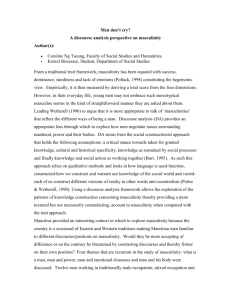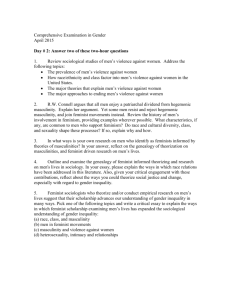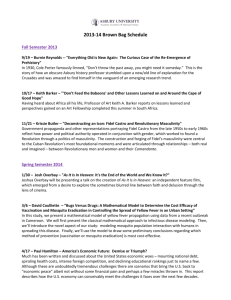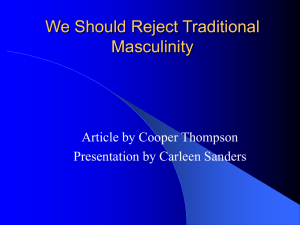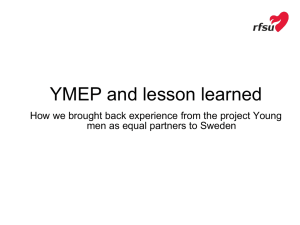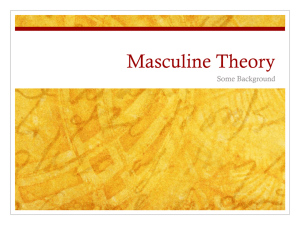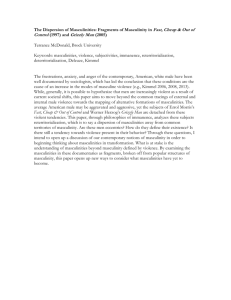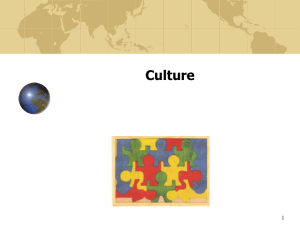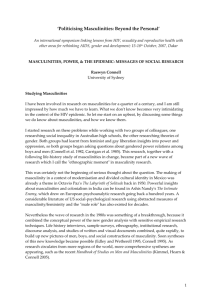Research on Masculinities from a global perspective
advertisement
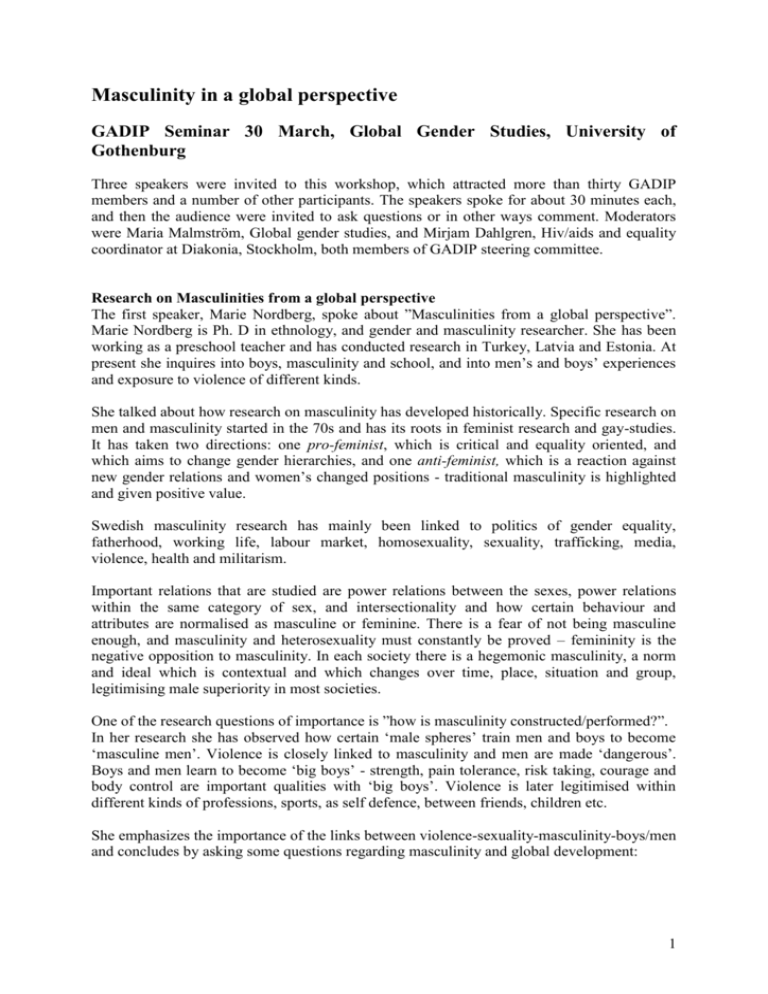
Masculinity in a global perspective GADIP Seminar 30 March, Global Gender Studies, University of Gothenburg Three speakers were invited to this workshop, which attracted more than thirty GADIP members and a number of other participants. The speakers spoke for about 30 minutes each, and then the audience were invited to ask questions or in other ways comment. Moderators were Maria Malmström, Global gender studies, and Mirjam Dahlgren, Hiv/aids and equality coordinator at Diakonia, Stockholm, both members of GADIP steering committee. Research on Masculinities from a global perspective The first speaker, Marie Nordberg, spoke about ”Masculinities from a global perspective”. Marie Nordberg is Ph. D in ethnology, and gender and masculinity researcher. She has been working as a preschool teacher and has conducted research in Turkey, Latvia and Estonia. At present she inquires into boys, masculinity and school, and into men’s and boys’ experiences and exposure to violence of different kinds. She talked about how research on masculinity has developed historically. Specific research on men and masculinity started in the 70s and has its roots in feminist research and gay-studies. It has taken two directions: one pro-feminist, which is critical and equality oriented, and which aims to change gender hierarchies, and one anti-feminist, which is a reaction against new gender relations and women’s changed positions - traditional masculinity is highlighted and given positive value. Swedish masculinity research has mainly been linked to politics of gender equality, fatherhood, working life, labour market, homosexuality, sexuality, trafficking, media, violence, health and militarism. Important relations that are studied are power relations between the sexes, power relations within the same category of sex, and intersectionality and how certain behaviour and attributes are normalised as masculine or feminine. There is a fear of not being masculine enough, and masculinity and heterosexuality must constantly be proved – femininity is the negative opposition to masculinity. In each society there is a hegemonic masculinity, a norm and ideal which is contextual and which changes over time, place, situation and group, legitimising male superiority in most societies. One of the research questions of importance is ”how is masculinity constructed/performed?”. In her research she has observed how certain ‘male spheres’ train men and boys to become ‘masculine men’. Violence is closely linked to masculinity and men are made ‘dangerous’. Boys and men learn to become ‘big boys’ - strength, pain tolerance, risk taking, courage and body control are important qualities with ‘big boys’. Violence is later legitimised within different kinds of professions, sports, as self defence, between friends, children etc. She emphasizes the importance of the links between violence-sexuality-masculinity-boys/men and concludes by asking some questions regarding masculinity and global development: 1 How do western gender models, categories of sexuality and gender theories affect our understanding of gender relations and our view of women and men in different countries? How is development work affected by our expectations directed towards boys and men in different societies and in different groups of men? How are men punished for diverging from and/or questioning norms of masculinity and how are those who adjust rewarded? Men raped by men The second speaker, Hans Knutagård was a graduate from School of social studies, and M. Sc. in social work. He works with sexual health at the unit for social medicine, Region Skåne. He has among other things written about threats and violence related to the idea of ‘honour’; about being homosexual and homo-hostile violence; and about men selling sex. At present he writes about men who have been raped by men, which is also the topic of his presentation at the seminar. To illustrate the problem he started by telling us a story of a young man who was ‘picked up’ by another man on the internet and with whom he set up a date. The date did not turn out as he had wished, instead he had a very negative and violent experience of having sex with a man that also turned out to be much older than expected. However, not until he spoke to his sister, he realised that he had actually been raped. This brings up a number of problems connected to men who are raped: There is for example a general view that ‘men are not raped’ and it is therefore difficult to put the experience into words, and to name it as ‘rape’. The general view is that women are raped, but there is very little research and discussion about men who are raped by men; men who are raped by women; and women who are raped by women. Another general view is that if you do not resist physically the act cannot be named as rape. Especially a man who should be strong and physically able to resist. Not having resisted creates feelings of shame and makes it difficult for the one subjected to the abuse to use the word ‘rape’. The fact that men may get an erection when they are raped or subjected to other forms of sexual assault also creates a feeling of shame, and makes it difficult for men to put the assault in words. Commonly, men react to stress in this way, erection thus not always is a physical reaction related to attraction or being aroused. Also hostility towards homosexual people makes it difficult to talk about and also to report to the police. He said it is also very difficult to get any support or help from public medical service, since there has been very little attention paid to the problem. Religion and Masculinity with a focus on children Soleyman Ghaseiani from the social services in Gothenburg made a presentation on the religious impact on ideas of masculinity. Speaking from an experience of being brought up as a child in Kurdish Iran, and living in Sweden since the 1980’s, Ghaseiani contended that the hegemonic masculinity essentially is the same in Sweden and Iran. His argument was that although the importance explicitly given to religion differ in East and West, which were the concepts Ghaseiani used, the patriarchy in the religions of the Book are the same, which is 2 reflected in contemporary society in both parts of the world. God is unquestionably a He in both the Bible and Koran. All the characteristics ascribed God are ascribed men, such as strong, powerful, almighty, and great. With personal narratives on how he as a six year-old boy had to suffer circumcision without being allowed to cry or show the fear he felt inside, Ghaseiani illustrated how family and kin foster and mould a boy into a man that is strong and in control of his feelings, in particular anxiety and sorrow. Ghaseiani made comparison with the practice of female circumcision in Kurdish society. According to him, this is a duty that should be performed discreetly, while the boy’s circumcision is celebrated. Listening to the boy in his narrative, we were made to understand that this was felt as a paradox to the little boy: he was subjected to pain, and the family and neighbours were celebrating, announcing: “our son has become a man, he’s now circumcised!” In a strongly patriarchial society as Iran men and violence are linked. Women should be soft and tender, while men should use violence to protect the family. Men are compelled to “educate” (that is, use physical violence against) his children and wife. It is not called child abuse or domestic violence but a responsibility given man by God. The difference between Sweden and Iran is that those that are in power in the latter are conservative patriarchial leaders who have the power to define how the religion should be interpreted and practiced. In Sweden, it is more accepted that men cry, and domestic violence and child abuse is not tolerated. In the East, as Ghaseiani said, conservative forces use religion as an argument to retain the political, economic and social power, and suppress other interpretations of religion than their own. Debate In the debate, the concept of masculinity was problematised. Nordberg pointed out that the religious patriarchy is built on men who according to the norm should be both loving and controlling, and that in this system other men than those in authority are subordinated as well as women. The question of honour violence was raised, and the fact that brothers are fostered to control their sisters. How do we contribute to a change of gender roles, and how is the hegemonic masculinity that Ghaseiani spoke of reproduced in exile in Sweden? This is done in the family sphere; norms are inculcated in children from early childhood. A comparison was made with Swedish kindergarten, where personnel very explicitly strive to be gender neutral, but studies show that in practice boys still are made into boys and girls into girls in stereotypic ways. Concerning honour violence, Sharif’s Hjältar (Sharif’s Heroes)* were lifted up as an example. It was agreed that change cannot come from outside the particular group. The debate was lifted to a larger context where violent masculinity as a norm is not just a growing fact in Swedish schools but also around the world. The ethnopolitical demands in South Africa were mentioned as an example. The strengthening of ethnic and national identity in SA increasingly has been linked to masculinity and control of women, for instance in dress codes and collective virginity tests, which is actually a new phenomenon but none the less talked of in terms of “old custom”. The trial against Jacob Zuma is a case in point showing masculinity used as a political project, which is was contended is a trend in the era of the new globalisation marked by neoliberal ideals and anti-terror politics. 3 *Sharifs Hjältar is a team of male youth from foremost Middle Eastern countries who in Sweden fight honour violence by resisting the attitudes related to these cultural perceptions of gender and sexuality aiming at being new role models for young men. 4
